Highlights
Probing structural superlubricity of two-dimensional water transport with atomic resolution
Low-dimensional water transport can be drastically enhanced under atomic-scale confinement. However, its microscopic origin is still under debate. In this work, we directly imaged the atomic structure and transport of two-dimensional water islands on graphene and hexagonal boron nitride surfaces using qPlus-based atomic force microscopy. The lattice of the water island was incommensurate with the graphene surface but commensurate with the boron nitride surface owing to different surface electrostatics. The area-normalized static friction on the graphene diminished as the island area was increased by a power of ~–0.58, suggesting superlubricity behavior...
( Science ) PDF Download
Report: PKUPhy news.
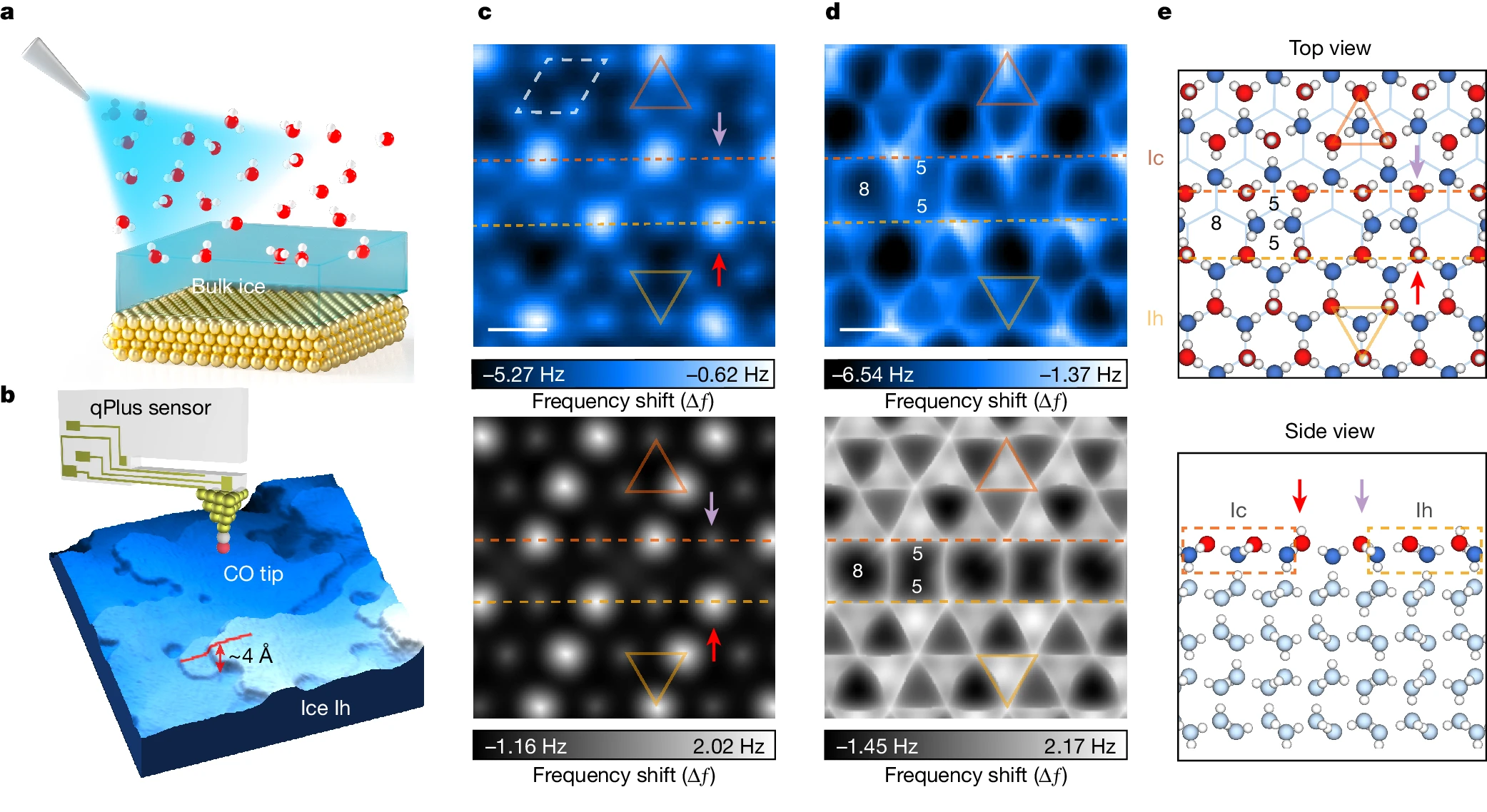
Imaging surface structure and premelting of ice Ih with atomic resolution
Ice surfaces are closely relevant to many physical and chemical properties, such as melting, freezing, friction, gas uptake and atmospheric reaction1,2,3,4,5,6,7,8. Despite extensive experimental and theoretical investigations9,10,11,12,13,14,15,16,17, the exact atomic structures of ice interfaces remain elusive owing to the vulnerable hydrogen-bonding network and the complicated premelting process. Here we realize atomic-resolution imaging of the basal (0001) surface structure of hexagonal water ice (ice Ih) by using qPlus-based cryogenic atomic force microscopy with a carbon monoxide-functionalized tip. We find that the crystalline ice-Ih surface consists of mixed Ih- and cubic (Ic)-stacking nanodomains, forming periodic superstructures...
( Nature ) PDF Download
Report: PKUPhy news.

Nanoscale one-dimensional close packing of interfacial alkali ions driven by water-mediated attraction
The permeability and selectivity of biological and artificial ion channels correlate with the specific hydration structure of single ions. However, fundamental understanding of the effect of ion–ion interaction remains elusive. Here, via non-contact atomic force microscopy measurements, we demonstrate that hydrated alkali metal cations (Na+ and K+) at charged surfaces could come into close contact with each other through partial dehydration and water rearrangement processes, forming one-dimensional chain structures. We prove that the interplay at the nanoscale between the water–ion and water–water interaction can lead to an effective ion–ion attraction overcoming the ionic Coulomb repulsion...
( Nature Nanotechnology ) PDF Download
Report: PKUPhy news.
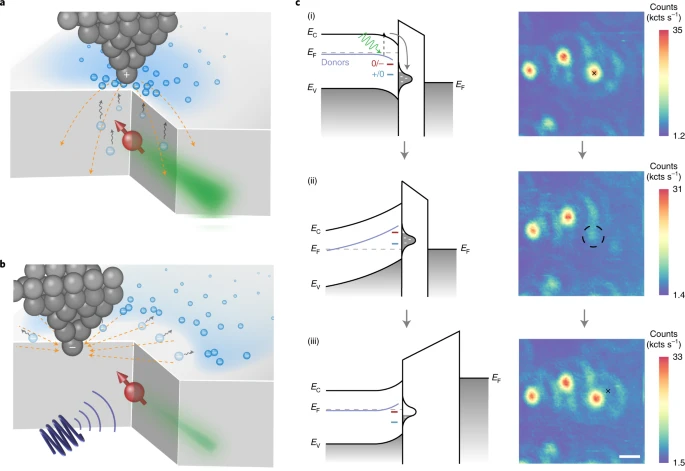
Coherence enhancement of solid-state qubits by local manipulation of the electron spin bath
The performance of qubit-based technologies can be strongly limited by environmental sources of noise and disorder that cause decoherence. Qubits used in quantum sensing are usually very close to the host surface to enhance their coupling to external targets. This leaves them vulnerable to the effects of the surrounding noisy electron spin bath near the surface, which is very challenging to eliminate. Here we developed an efficient method to engineer the immediate electrostatic environment of nitrogen vacancy centre qubits located several nanometres beneath the diamond surface. We adopt a ‘pull-and-push’ strategy for near-surface charge manipulation using the strong local electric field of an atomic force microscope tip ...
( Nature Physics ) PDF Download
Report: PKU news.
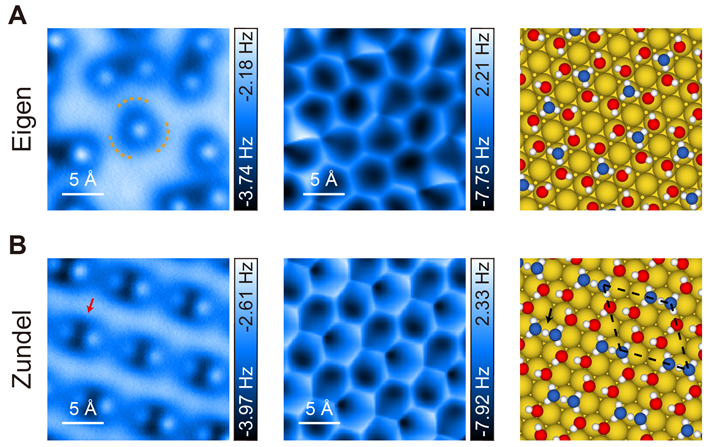
Visualizing Eigen/Zundel cations and their interconversion in monolayer water on metal surfaces
Hydrated protons play a critical role in numerous physical and chemical processes. However, their atomic-level characterization remains experimentally challenging, especially for interfacial systems. Using qPlus-based atomic force microscopy and path integral molecular dynamics, Tian et al. demonstrated real-space imaging of the most representative forms of hydrated protons, the Zundel and the Eigen cations, at water networks grown on Au(111) and Pt(111) surfaces and characterized the preferable two dimensional assemblies of these cations at the interfaces ...
(Science 377, 6603 (2022)) PDF Download
Report: PKU news,
PKU news(English edition),
Zhi She.
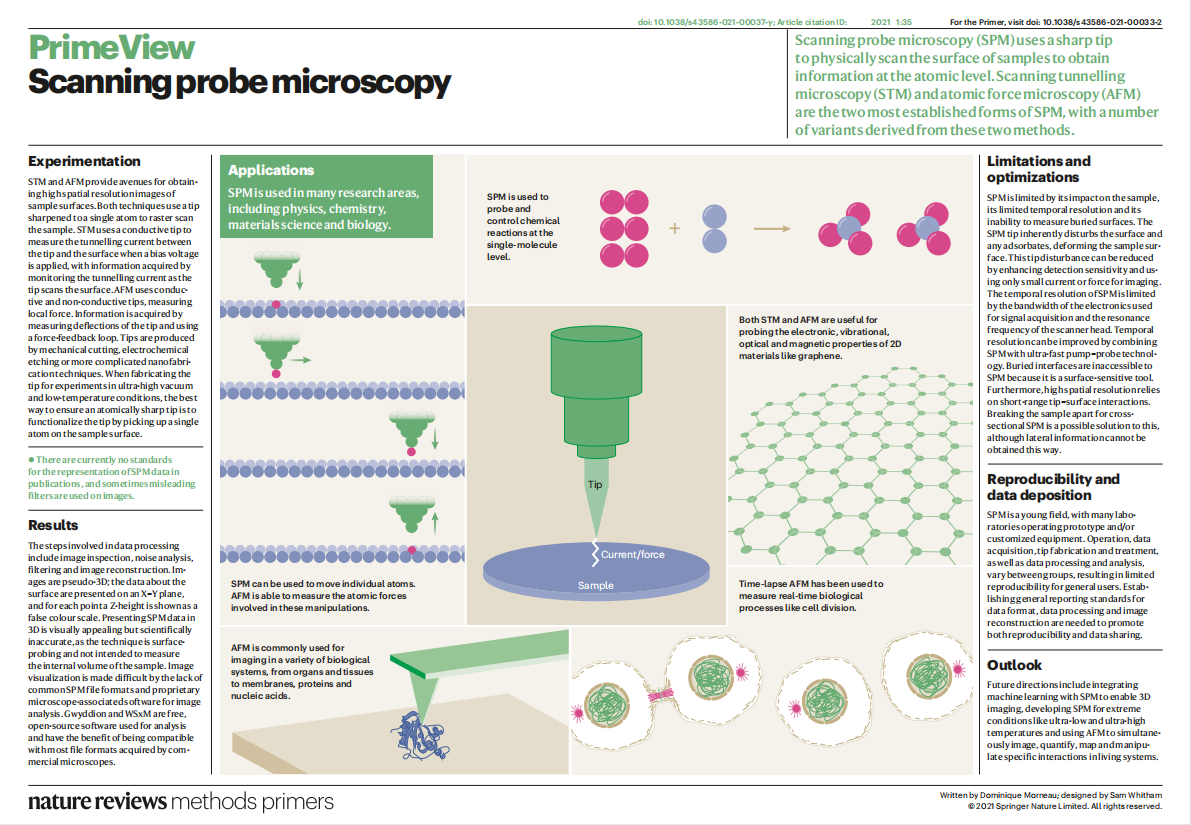
Scanning probe microscopy
Scanning probe microscopy (SPM), a key invention in nanoscience, has by now been extended to a wide spectrum of basic and applied fields. Its application to basic science led to a paradigm shift in the understanding and perception of matter at its nanoscopic and even atomic levels. SPM uses a sharp tip to physically raster-scan samples and locally collect information from the surface. Various signals can be directly detected by SPM in real space with atomic or nanoscale resolution, which provides insights into the structural, electronic, vibrational, optical, magnetic, (bio)chemical and mechanical properties. This Primer introduces the key aspects and general features of SPM and SPM set-up and variations ...
(Nat Rev Methods Primers 1, 36 (2021)) PDF Download,
Poster Download
Report: PKU news,
Zhi She.

Nanoscale electric-field imaging based on a quantum sensor and its charge-state control under ambient condition
Nitrogen-vacancy (NV) centers in diamond can be used as quantum sensors to image the magnetic field with nanoscale resolution. However, nanoscale electric-field mapping has not been achieved so far because of the relatively weak coupling strength between NV and electric field. Here, using individual shallow NVs, we quantitatively image electric field contours from a sharp tip of a qPlus-based atomic force microscope (AFM), and achieve a spatial resolution of ~10 nm. Through such local electric fields, we demonstrated electric control of NV’s charge state with sub-5 nm precision. This work represents the first step towards nanoscale scanning electrometry based on a single quantum sensor ...
(Nature Communications 12, 2457 (2021)) PDF Download
Report: PKU news.

Surface coordination layer passivates oxidation of copper
Owing to its high thermal and electrical conductivities, its ductility and its overall non-toxicity, copper is widely used in daily applications and in industry, particularly in anti-oxidation technologies. However, many widespread anti-oxidation techniques, such as alloying and electroplating, often degrade some physical properties (for example, thermal and electrical conductivities and colour) and introduce harmful elements such as chromium and nickel. Although efforts have been made to develop surface passivation technologies using organic molecules, inorganic materials or carbon-based materials as oxidation inhibitors...
(Nature 586(7829) 390-394 (2020)) PDF Download
Report: PKU news.
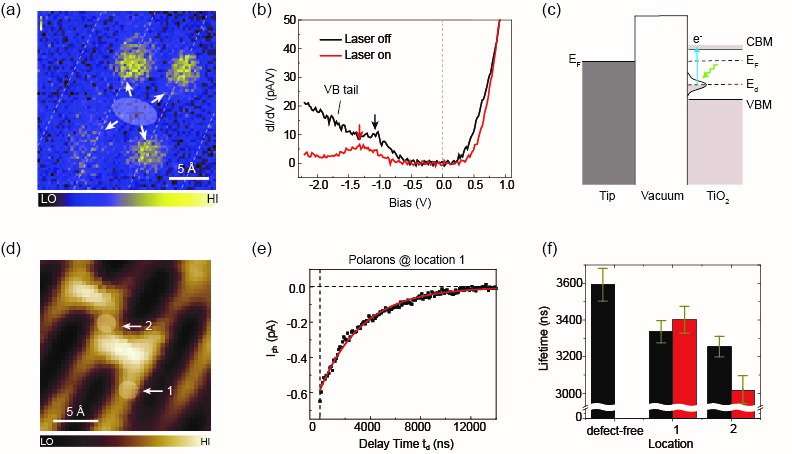
Probing Nonequilibrium Dynamics of Photoexcited Polarons on a Metal-Oxide Surface with Atomic Precision
Understanding the nonequilibrium dynamics of photoexcited polarons at the atomic scale is of great importance for improving the performance of photocatalytic and solar-energy materials. Using a pulsed-laser-combined scanning tunneling microscopy and spectroscopy, here we succeeded in resolving the relaxation dynamics of single polarons bound to oxygen vacancies on the surface of a prototypical photocatalyst, rutile titanium dioxide. The visible-light excitation of the defect-derived polarons depletes the polaron states and leads to delocalized free electrons in the conduction band detail... (
Physical Review Letters 124 206801 (2020))
PDF Download Report: PKU news,
PKU news (english edition),
Zhi She,
Chinese Science Bulletin.

Atomic imaging of the edge structure and growth of a two-dimensional hexagonal ice
We report that noncontact atomic-force microscopy with a CO-terminated tip enables real-space imaging of the edge structures of 2D bilayer hexagonal ice grown on a Au(111) surface. We find that armchair-type edges coexist with the zigzag edges usually observed in 2D hexagonal crystals, and freeze these samples during growth to identify the intermediate edge structures. These experiments enable us to reconstruct the growth processes that, in the case of the zigzag edge, involve the addition of water molecules to the existing edge and a collective bridging mechanism. more... (
Nature 577 60-63 (2020))
PDF Download Report: PKU news,
Physics World,
Nature Reviews Chemistry,
PKU news (English version),
Science and Technology Daily,
Zhi She,
Kou Xiang,
Chinese Science Bulletin,
National Natural Science Fundation of China.

Boundary activated hydrogen evolution reaction on monolayer MoS2
we report a facile route toward the activation of the monolayer MoS2 basal plane for HER by introducing domain boundaries, including both 2H–2H domain boundaries and 2H–1T-phase boundaries. We found that the domain boundaries can provide ultrahigh-density active sites, while still maintain the surface stability. more... (
Nature Communications 10:1348 (2019))
PDF Download
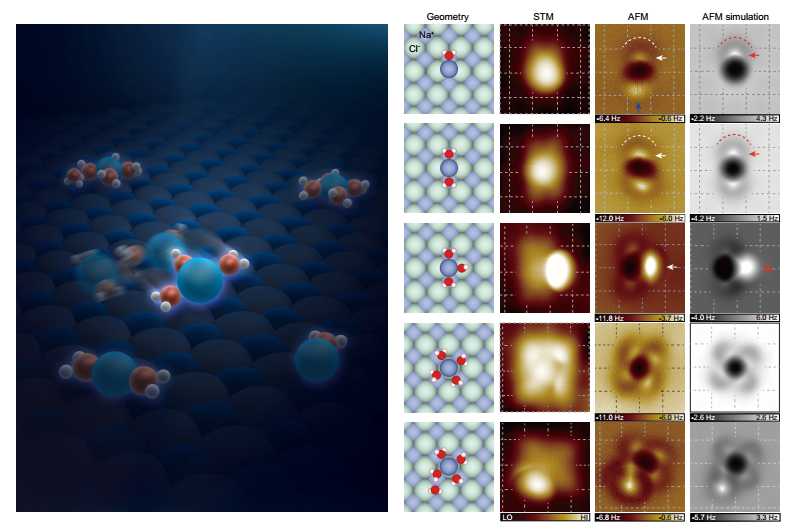
The effect of hydration number on the interfacial transport of sodium ions
We constructed individual sodium ion (Na+) hydrates on a NaCl(001) surface by progressively attaching single water molecules (one to five) to the Na+ ion using a combined scanning tunnelling microscopy and noncontact atomic force microscopy system. We found that the Na+ ion hydrated with three water molecules diffuses orders of magnitude more quickly than other ion hydrates. more... (
Nature 557, 701-705 (2018))
PDF Download
video Download Report: PKU news,
PKU news (english edition),
Nature Review Chemisty,
Nature Research Chemistry Community,
Xinhua news,
CCTV,
People's Daily,
China Science Daily,
Guangming Daily,
sina news
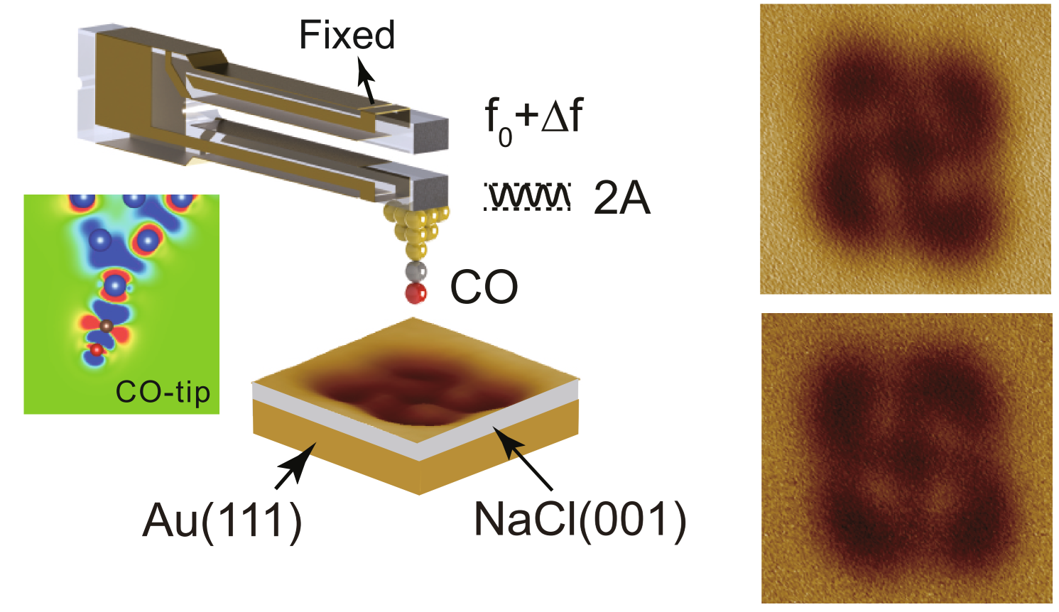
Weakly perturbative imaging of interfacial water with submolecular resolution by atomic force microscopy
Here, we report submolecular-resolution imaging of the water clusters on a NaCl(001) surface within the nearly noninvasive region by a qPlus-based noncontact atomic force microscopy. Comparison with theoretical simulations reveals that the key lies in probing the weak high-order electrostatic force between the quadrupole-like CO-terminated tip and the polar water molecules at large tip–water distances. more... (
Nature Communications 9:122 (2018))
PDF Download Report: PKU news,
PKU news (english edition),
Chinese Science Bulletin
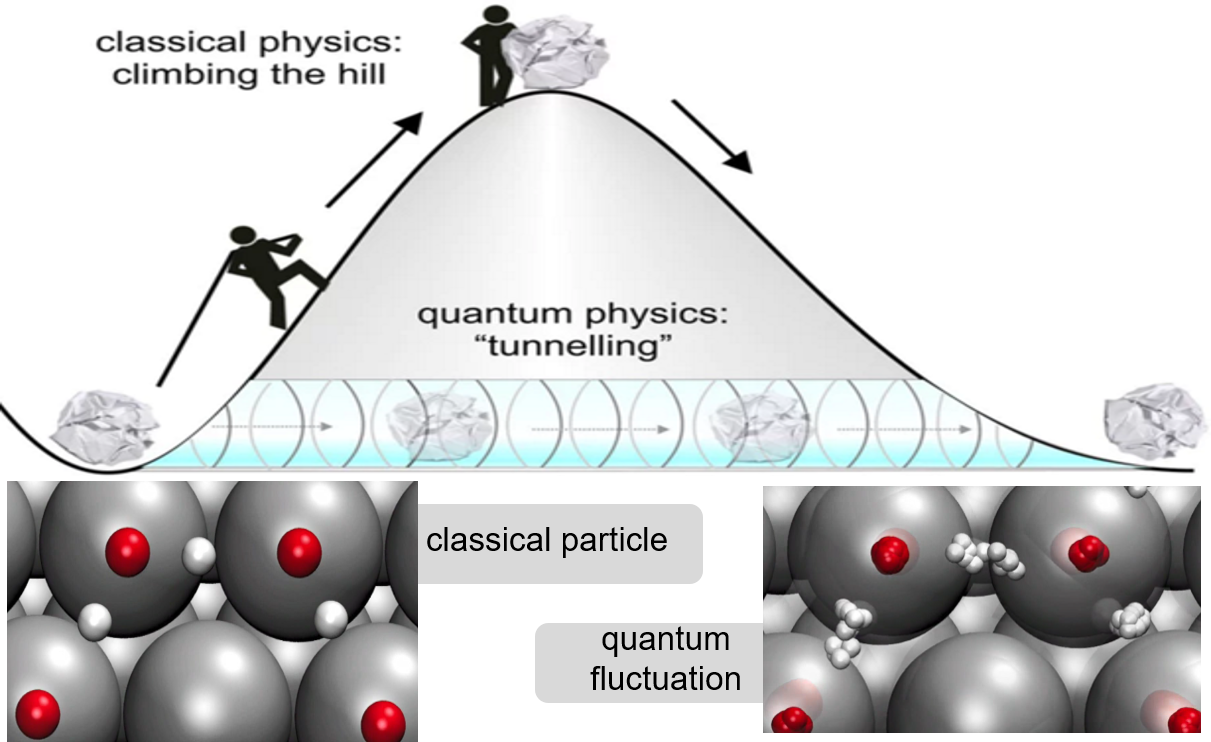
Atomic-scale investigation of nuclear quantum effects of surface water: Experiments and theory
In this review article, we will highlight the recent advances of scanning tunneling microscopy and spectroscopy (STM/S), which allows the access to the quantum degree of freedom of protons both in real and energy space. In addition, we will also introduce recent development of ab initio path-integral molecular dynamics (PIMD) simulations at surfaces/interfaces, in which both the electrons and nuclei are treated as quantum particles in contrast to traditional ab initio molecular dynamics (MD). more... (
Progress in Surface Science 92, 203–239 (2017))
PDF Download
Report: PKU news.
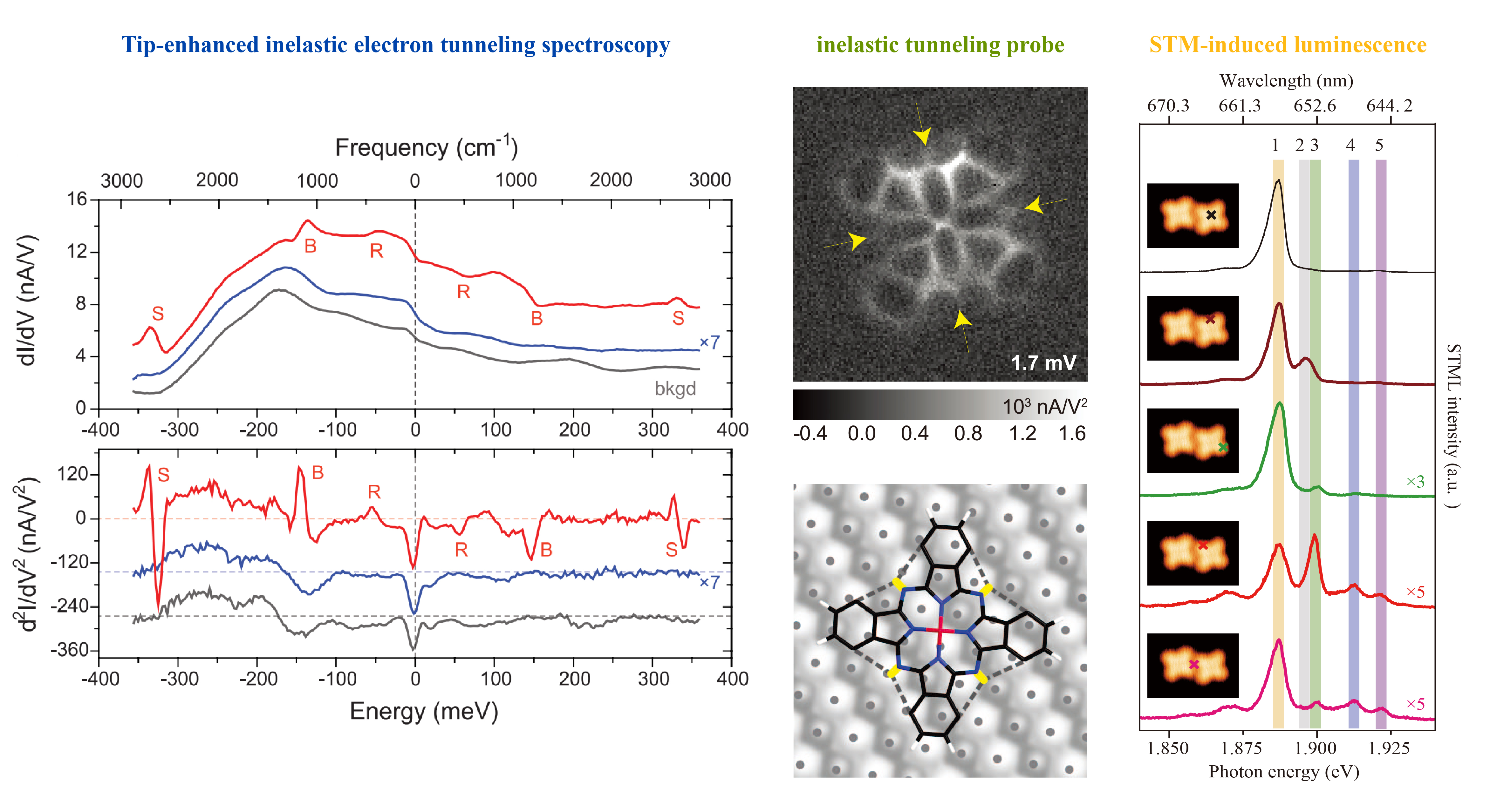
Recent advances in inelastic electron tunneling spectroscopy
In this review, we mainly focus on the new development and application of STM-IETS in the past decade. After introducing the basic theoretical background of IETS, we will discuss the recent advances of STM-IETS as vibrational spectroscopy and microspectroscopy, with emphasis on the ability of probing weak intermolecular interactions. more... (
Advances in Physics: X 2:3, 907 (2017))
PDF Download
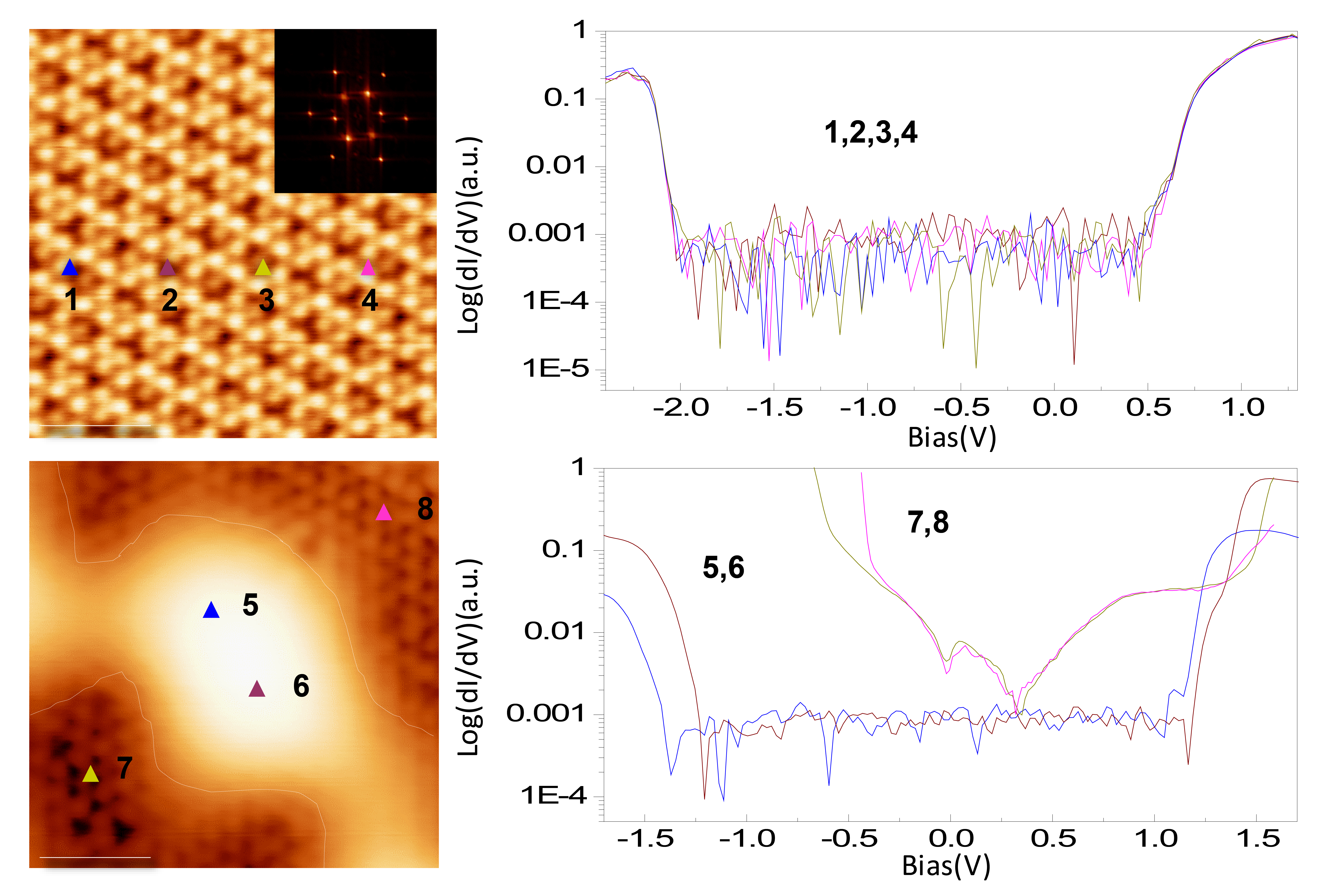
Argon Plasma Induced Phase Transition in Monolayer MoS2
In this work, we report a facile, clean, controllable and scalable phase engineering technique for monolayer MoS2. We found that weak Ar-plasma bombardment can locally induce 2H→1T phase transition in monolayer MoS2 to form mosaic structures. These 2H→1T phase transitions are stabilized by point defects (single S-vacancies) and the sizes of induced 1T domains are typically a few nanometers, as revealed by scanning tunneling microscopy measurements. more... (
Jaurnal of the American Chemical Society 139, 10216 (2017))
PDF Download
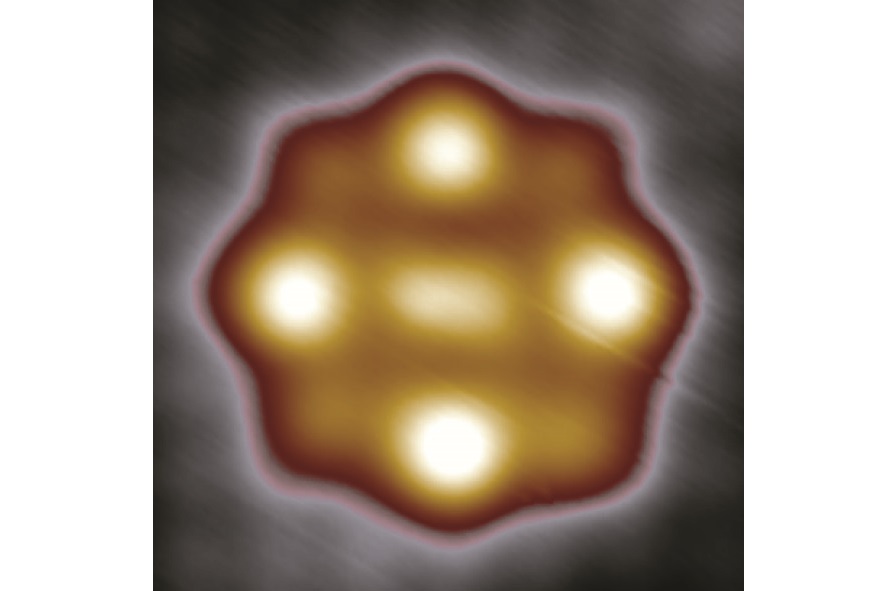
Perspective: Structure and dynamics of water at surfaces probed by scanning tunneling microscopy and spectroscopy
In this perspective, we review the recent advances of STM techniques in imaging, spectroscopy, and manipulation of water molecules. We discuss how those newly developed techniques are applied to probe the structure and dynamics of water at solid surfaces with single-molecule and even submolecular resolution, paying particular attention to the ability of accessing the degree of freedom of hydrogen. (
Journal of Chemical Physics 145, 160901 (2016))
PDF DownloadReport: PKU news,
PKU news (english edition) .

Nuclear quantum effects of hydrogen bonds probed by tip-enhanced inelastic electron tunneling
We report the quantitative assessment of nuclear quantum effects on the strength of a single hydrogen bond formed at a water-salt interface, using tip-enhanced inelastic electron tunneling spectroscopy based on a scanning tunneling microscope. The inelastic scattering cross section was resonantly enhanced bymore...(
Science 352, 6283(2016))
PDF DownloadReport: PKU news,
PKU news (english edition) ,
Science ,
Asian scientist,
CCTV,
China Scinece Daily,
Guangming Daily,
Science and Technology Daily,
Acta Phys. -Chim. Sin.
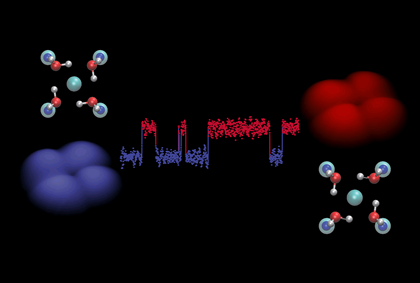
Concerted proton tunnelling
We report the real-space observation of concerted proton tunnelling in a cyclic water tetramer using a cryogenic STM. This is achieved by monitoring the reversible interconversion of the hydrogen-bonding chirality of the water tetramer with a chlorine-terminated STM tip. more...(
Nature Physics 11, 235(2015))
PDF DownloadReport: PKU news,
Nature Physics(Tunnelling in chiral water clusters: Protons in concert),
AsianScientist(Watching Water Do Quantum Tunneling),
Phys.org(Now you see it: Real-space observation of many-body proton tunneling in water nanocluster).
 film.png)
Unconventional bilayer ice structure
Using a cryogenic STM, we report a new type of 2D ice-like bilayer structure built from cyclic water tetramers on an insulating NaCl(001) film, which is completely beyond this conventional bilayer picture. A novel bridging mechanism allows the interconnection of water tetramers to form chains, flakes and eventually a two-dimensional extended ice bilayer containing a regular array of Bjerrum D-type defects. (
Nature Communications 5, 4056(2014))
PDF Download Report: PKU news,
AsianScientist(How Ice Forms On Salt).
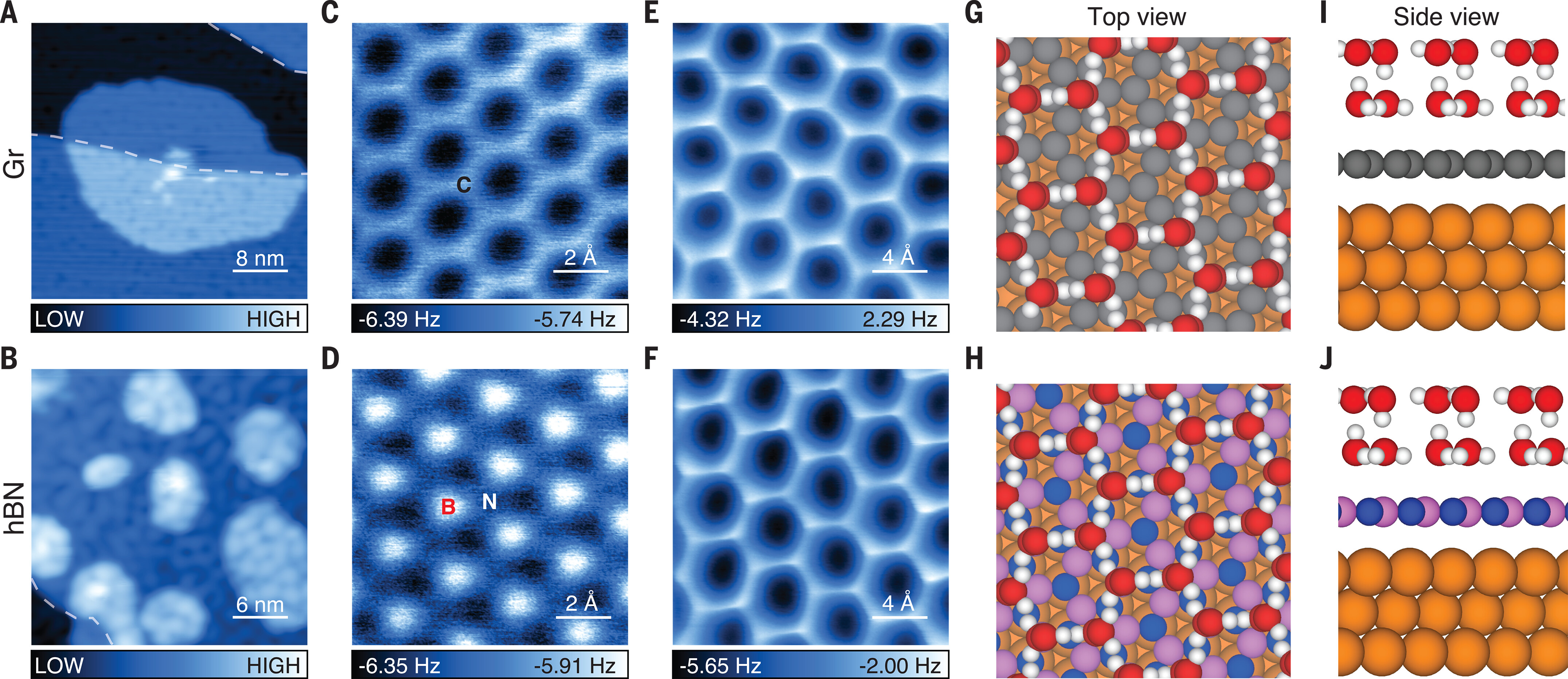

















 film.png)